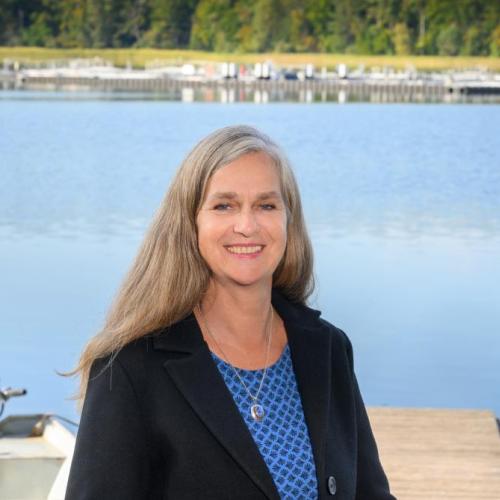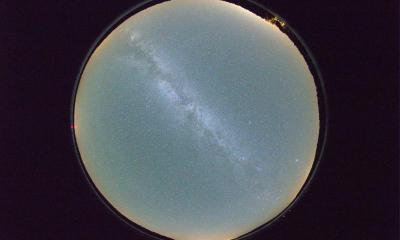The assembly of the largest experimental cylinder took place in March 2011 on the ice surface of Lake Stechlin near the shore. | Photo: IGB
The first experiments in the LakeLab: the effects of extreme storm events on lakes
© Martina Bauchrowitz
The first experiment in the LakeLab was conducted in summer 2013 as part of the project Climate-driven changes in the biodiversity of microbiota (TemBi) funded by the Leibniz Association. The question was how stratified clear-water lakes respond to a lowering of the thermocline due to storm events. For this purpose, the thermocline was deepened by 2 meters in 3 experimental enclosures of the LakeLab. Three additional enclosures served as controls. Building on the initial experience and strengthened by expertise contributed by Stella Berger and Jens Nejstgaard, who could take on the coordination and further development of the LakeLab thanks to an infrastructure project of the German Research Foundation (DFG), it was possible in the following year to investigate the effects of an extreme weather event with deep mixing of the stratified enclosures from 7 to 14 meters.
Hans-Peter Grossart, one of the two TemBi project leaders, explained: "We could show in this experiment that the entrainment of deep water in the surface water layer by a strong summer storm can trigger blooms of potentially toxic cyanobacteria." "This leads to increased microbial metabolism and nutrient recycling in the surface water," added Thomas Hornick, his doctoral student at the time. Consequently, extreme summer storms, which are expected to occur more frequently in the future, can have far-reaching effects on stratified lakes. This is especially true for nutrient-poor clear-water lakes, which have been little affected by humans in the past.
The consequences of nutrient inputs into lakes following heavy rainfall
© Martina Bauchrowitz
A similar question was addressed by the EU Commission-funded project Managing Aquatic ecosystems and water Resources under multiple Stress (MARS) in summer 2015. This time, however, the focus was not on the effects of changes in lake physics, but on the consequences of nutrient inputs from the catchment after heavy rainfall, which often accompanies storms. The results showed that lake browning by humic substances supplied during precipitation events strongly counteracts the stimulation of phytoplankton by nutrients received by lakes the same time. Only in enclosures without humic substances, where light levels were sufficient, did nutrient inputs stimulate algal production. Cyanobacteria were particularly sensitive, being almost completely suppressed by humic substances.
This led Mark Gessner, who coordinated the project with Anne Lyche Solheim of the Norwegian Water Research Institute in Oslo, to conclude that "if extreme precipitation events continue to increase in frequency and intensity as a result of climate change, not only are substantial changes in carbon and nutrient fluxes in lakes to be expected, there will also be a tendency for potentially toxic cyanobacteria to be suppressed, despite increased nutrient availability."
The LakeLab as an international hub for aquatic research
 © Martina Bauchrowitz
© Martina Bauchrowitz
As part of an EU infrastructure project, more than 20 research institutions and universities and three companies from twelve European countries joined forces in 2017. This Network of Leading European AQUAtic MesoCOSMos Facilities from the Arctic to the Mediterranean (AQUACOSM) was initiated and coordinated by Jens Nejstgaard, was coordinated by Jens Nejstgaard, was coordinated by Jens Nejstgaard, as is the follow-up project AQUACOSM-plus. "In these projects, we are establishing the systematic cooperation and harmonization of operating procedures at European experimental mesocosm facilities in inland and coastal waters as well as in the open ocean," he explained. As one of the largest infrastructures in this European network, the LakeLab has become a centre of attraction for researchers from all over the world. Up to 70 persons have participated in individual large-scale experiments.
Internationally established research groups and trainees have been supported through the Transnational Access (TA) Program of AQUACOSM and AQUACOSM-plus. "This program offers researchers a total of more than 20,000 access days to experimental facilities, including the LakeLab, and provides logistical, technical and scientific support, as well as reimbursement for travel and lodging expenses during the duration of an experiment", said Stella Berger, coordinator of the TA program.
How do urban lake ecosystems respond to light pollution?
%20(1)_0.jpg)
© Andreas Jechow
Anthropogenic pressures on lakes extend far beyond climate change. One of the critical pressures is light pollution, which is rapidly increasing worldwide not only of urban waters. This contrasts with the LakeLab in Lake Stechlin as one of the darkest places in Germany and a largely natural night sky. These are ideal conditions to investigate effects of light pollution on lake ecosystems.
Using a purpose-built lighting system, a diffuse, low-level light pollution, also known as skyglow, was simulated in the LakeLab in the summer of both 2016 and 2018 in the project Illuminating Lake EcoSystems (ILES) which is funded by the Leibniz Association. The control cylinders were illuminated only by natural moonlight and starlight. Skyglow occurs when nighttime artificial light in urban areas is scattered by airborne particles and some of it reflects back to the Earth's surface. Over cities, the resulting bell of light is visible even at great distances. The focus of the two large-scale experiments was the response of the aquatic food web and nutrient cycles to this light pollution.
A special attraction during the experiment was the boat rides and sampling on the lake before sunrise – in beautiful weather under an impressive starry sky. "Despite the extremely low light level, subtle changes were detectable at all levels of the food web – from bacteria, algae and aquatic plants to small zooplankton and fish," explained Franz Hölker, who coordinated the project together with Mark Gessner.
A test site for data collection by remote sensing
.jpg) © 3edata, Carmen Cillero
© 3edata, Carmen Cillero
A view from above changes our perspective – also on water bodies. With technical developments rapidly advancing, remote sensing methods are thus becoming increasingly interesting also for water research. For example, the colour of water determined from a bird's eye view allows conclusions to be drawn about how heavily lakes are polluted with nutrients and how quickly algal blooms spread in lakes connected by rivers.
As part of the CONNECT project, funded by the Leibniz Association and coordinated by Stella Berger and Sabine Wollrab, a LakeLab experiment was conducted in 2019 to address the influence of water residence time on the spread of nutrient pulses and algal bloom development in lake chains. Combining methods of remote sensing with sensor and laboratory measurements enabled the evaluation of remote sensing data as an important basis for their possible future use in lake monitoring. The measurements made during the experiment showed that water residence time, which was experimentally varied in the enclosures, is indeed important for the development and spread of algal biomass to other lakes when triggered by a nutrient pulse.
"Based on these results, we can make more accurate statements about the range of effects of pulsed nutrient inputs into lakes connected by rivers," explained Stella Berger. "Our theoretical models for the propagation of nutrient pulses and algal blooms in lake chains also support the data," added Sabine Wollrab. This provides a good basis for predicting future developments of lake ecosystems in the face of climate change.
An internationally coordinated experiment on the consequences of extreme weather events for bodies of water
_0.jpg)
© Harald Franzen
Extremely hot summers, extremely high precipitation and extremely violent storms are increasingly shaping the weather situation in Germany, Europe and worldwide. How variable are the impacts of such events for water bodies and their biodiversity – depending on catchment conditions, the nature of the water bodies, climate, season and many other factors? To answer this question, a Joint Mesocosm Experiment (JOMEX), coordinated across Europe, was carried out as part of the AQUACOSM project to compare the effects of the inputs of humic substances and nutrients into different aquatic ecosystems extending from the Mediterranean to the Arctic.
The LakeLab participated in the summer of 2021 as well. "I am very pleased that we managed to conduct these coordinated experiments over several years at many AQUACOSM sites across Europe. The unique data set shows that the effects of inputs of humic substances and nutrients is highly dependent on the type of ecosystem investigated. This also confirms that it is important to study effects over a wide range of ecosystems," stated Jens Nejstgaard.
The LakeLab over the next decade
 © Peter Casper
© Peter Casper
The 10th anniversary also marks the end of the first half of the permit to operate the LakeLab. In the second half, we will build on the original vision while also setting new priorities. The overarching goal remains to take advantage of the opportunities offered by the unique facility to improve our understanding of the responses of stratified lakes to rapid environmental change. It is crucial in this context to consider the complexity of lake ecosystem in order to realistically assess the joint impacts of the current climate and biodiversity crises. The research focus will continue to be on issues related to the consequences of climate change, including extreme events, but other aspects of global environmental change, such as light pollution and eutrophication phenomena will also continue to play a role. In times of rapid environmental change, it is urgent also to develop tangible solutions to improving the quality of our waters. Therefore, more experiments contributing directly to solving specific water problems are likely to be conducted in the coming decade.
For the design of future experiments, we will build on the experience of the first 10 years, and even more than before we will rely on state-of-the-art approaches. These include methods of remote sensing, high-resolution image analysis under field conditions, and characterization of communities and their activities by metagenome, metatranscriptome, and other OMICS-approaches. Artificial intelligence will also be increasingly used in data analysis. Furthermore, the LakeLab will serve as a test platform for instrument development, intercalibration and validation, for instance to compare sensor measurements with chemical analytical methods. Integrated into the newly designed Competence and Technology Platforms (CTP) of the IGB, the CTP LakeLab under the leadership of Stella Berger and Jens Nejstgaard will strengthen internal communication and expertise, promote international cooperation beyond the established European network of experimental facilities, bring together global expertise and enable coordinated experiments.
Aerial view of the LakeLab during an experiment with humic substances. | Photo: Andreas Jechow

Sampling of zooplankton as part of the MARS project. | Photo: Stella Berger

In the ILES project, some experimental cylinders of the LakeLab were illuminated, others were not. This allowed the IGB researchers to investigate the effects of light pollution on the aquatic food web. | Photo: Andreas Jechow
















